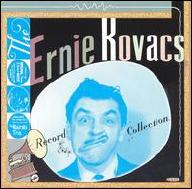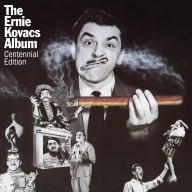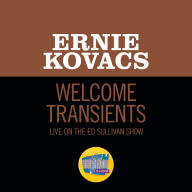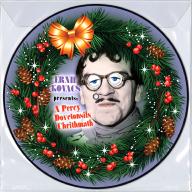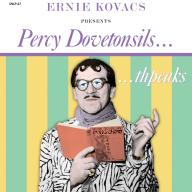Ernie Kovacs was born in Trenton, New Jersey on January 23, 1919. During Prohibition, Ernie's father made a small fortune as a bootlegger, and the youngster attended a prestigious private grade school where he first developed a taste for performing (and his mother indulged him by have custom-tailored costumes made for his appearances in school plays). By the time Kovacs entered high school, his father's days of wealth were over, and in public school Ernie became a poor and easily distracted student despite his intelligence. Though he flunked most of his subjects, Kovacs distinguished himself in school theater, and after graduating in 1937 (he had to repeat 12th grade due to his poor marks), he spent several months working in Summer Stock before attending the American Academy of Dramatic Arts on a scholarship. Between classes and working to support himself, Kovacs fell ill and spent two years in various hospitals after being diagnosed with pneumonia and pleurisy. After many months of indifferent treatment, Kovacs, who was never certain he actually had pneumonia, simply walked out and joined a theater company in Trenton, the Contemporary Players. Kovacs produced and directed a series of plays with them, as well as playing the male leads, but when one of their financiers skipped town with the box office take, Kovacs suddenly needed a job.
After moving in with his mother in Trenton and taking a job in a drugstore, Kovacs got a lucky break and was hired as an announcer at a radio station in Trenton, WTTM. Between 1941 and 1950, he went from announcing to hosting a late-night music show and directing special programs for the station, where his unique comic style began to take shape. He also acted in local theater productions, wrote a newspaper column, and did commentary on weekly wrestling matches. A recording of Kovacs calling a wrestling match made its way to a TV station in Philadelphia, WPTZ-TV, and soon he was holding down broadcasting jobs in both Trenton and Philadelphia. WPTZ-TV made Kovacs part of their on-camera staff, hosting a cooking show called Deadline for Dinner; he injected a considerable amount of comedy into the show, and it became a regional hit. The success of Deadline for Dinner led to Kovacs getting his own daily morning show, Three to Get Ready, where he improvised material alongside anarchic comedy sketches and introduced one of his best-known characters, the lisping and martini-fortified poet Percy Dovetonsils. Three to Get Ready became a success, but WPTZ was an NBC affiliate, and eventually the network insisted the station air their nationally broadcast morning show Today, and Three to Get Ready went off the air.
Kovacs wasn't off television for long. CBS quickly signed him to a mid-morning program called The Ernie Kovacs Show, but while the show fared well during the daytime, the decision to have Kovacs also do an evening program opposite Milton Berle (then the most popular comic on television) proved disastrous in the ratings, and Kovacs jumped ship to the fledgling Dumont Network in 1953. At Dumont, Kovacs was given considerable creative freedom, and he indulged his gift for satire and striking visual gags. However, Dumont was in poor financial shape (they would go out of business in 1956), and NBC lured him away with a lucrative contract in 1955. Kovacs was given a mid-morning show at the network, and in January 1957, he did a special half-hour show that followed another special starring Jerry Lewis. (Lewis' show was originally to run 90 minutes, and when Lewis decided only to do an hour and Kovacs was one of the only people in show business willing to fill the extra 30 minutes.) Kovacs' show, performed without dialogue, was a hit with both viewers and critics, and it led to an acting contract with Columbia Pictures -- he made his big-screen debut in 1957 in the comedy Operation Mad Ball. He also published a novel that year, Zoomar, inspired by his adventures in the television industry. (Kovacs would also pen numerous magazine pieces, including several early stories for Mad Magazine.) By this time, Kovacs had also released his first record, Ernie Kovacs Presents Buddy Weed … And Introduces Lynn Taylor, with him doing brief spoken bits alongside pianist Tad Weed and vocalist Lynn Taylor.
Over the next two years, Kovacs divided his time between film projects and occasional specials and guest shots for NBC, but in 1959, the network aired one of his most ambitions TV projects, Kovacs on Music, which included a guest appearance by Andre Previn and a performance of "Swan Lake" with all the dancers in gorilla suits. The show was sponsored by Dutch Masters' cigars (Kovacs was rarely far from a stogie on screen), which would become Kovacs' patron for many of his future TV projects, including a short-lived ABC series called Take a Good Look, a summer series of vintage silent movies with Ernie as host called Silents Please, and a handful of specials aired monthly on ABC, where Kovacs made some of his most elaborate and imaginative television work. Kovacs would win an Emmy award for one of the ABC specials, but he didn't live long enough to accept it; the final special was aired weeks after he died in an auto accident on January 13, 1962 at the age of 42.
Kovacs was married twice, and his second spouse, the singer and actress Edie Adams, devoted significant time and energy to keeping the legacy of his television work alive. Adams purchased the rights to most of his surviving TV shows, and after ABC aired a special, The Comedy of Ernie Kovacs, in 1968, highlights from his archives would later air in series on PBS and the Comedy Channel, while collections of his shows have been released on VHS and DVD. In 1976, Columbia Records would release The Ernie Kovacs Album, an LP drawn from spoken material that appeared on Kovacs' broadcasts, and Ernie Kovacs' Record Collection, a compilation of music that Ernie used on his shows, was issued by Varese Sarabande in 1997. Omnivore Recordings would release an expanded edition of The Ernie Kovacs Album in 2019; the fans at Omnivore had already issued Percy Dovetonsils … Thpeaks, an unreleased comedy album recorded in 1960 that finally saw release in 2012, as well as Ernie Kovacs Presents: A Percy Dovetonsils Crithmath in 2013. ~ Mark Deming, Rovi


